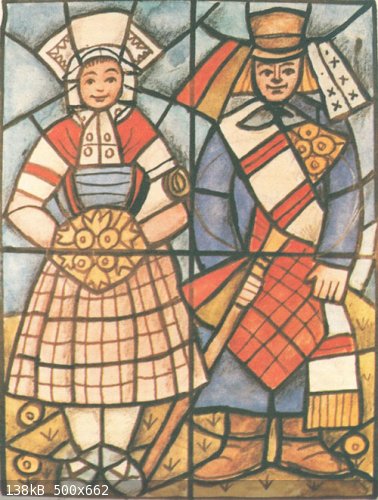Wendish Folklore Portfolio 5. SL PJAŃSKA SWARBA - Wedding in Schleife
5. SL PJAŃSKA SWARBA - Wedding in Schleife
Translated by Elmer Hohle

This portion was in German.
The wedding, as a portion of a lifespan, was inexorably entwined with love oracles and all-encompassing rich customs. Except for insignificant
remnants, these customs have largely disappeared in our area. The local customs of the Sorbs were in essence celebrated in similar fashion, however,
not only were there various different Sorbish customs practiced by the wedding party, but also the ceremonies themselves were varied. In our
particular area the tradition handed down for the past 100 plus years described the wedding practice as follows: If a young man had intentions to
court a young maiden, he would bring - either alone or with a retinue of courting suitors - a proposal to the girls' parents. If they were favorably
disposed to his intentions, more visits would ensue between both sets of parents in order to become familiar with the approaching circumstances and
the anticipated dowry. The ensuing engagement was confirmed with a verbal "yes" and a handshake. This was followed by a joint meal with his nearest
relatives. During the very short engagement period, the maiden already wore a different costume - instead of the usual red colors, blue and green were
worn.
Now begins the Wendish portion
Invitations to the wedding were issued through a braŝka. He also instigated and supervised the preparations for the wedding feast and
the slaughter of a calf or a steer. On the day of the wedding the groom, accompanied by a bagpipe player and a fiddler, along with his relatives, went
to fetch the bride from her parent's home. After an old woman, and then a bridesmaid were offered to him, he finally was given his true bride. For the
marriage ceremony special festive costumes were worn by all the participants. The groom wore a little "Rautenkranz" wreath on the back of his head, to
which were sewn green and white silk ribbons. Each male participant carried a staff with ribbons attached. The bride had a green head piece to which
was attached a "Rautenkranzlein" with two strands of white and green silk. In her laced bodice she wore a rosemary or myrtle wreath.
During the ride to the church, sweet meat confections and prunes were distributed to the onlookers. Upon entering the wedding home, the wedding party
received milk and beer from a new earthen pot. Then the pot was smashed. A person would first go through the stall where the cattle were given all
kinds of bread.
Now began the wedding feast. It consisted of eight courses. What the guests didn't eat was sent home with them in a pot. After all the eating, which
lasted into the dark of evening, everyone moved to the public hall for the dance. But the poor groom hardly got to dance with his bride. For, the
first dance went to the braŝka, then came all the groomsmen, after which all the other guests danced with her.
The celebration lasted two days. Eight days later was "boy wedding." The young wife wore wife-costumes and a bonnet with a pinned up scarf.
|